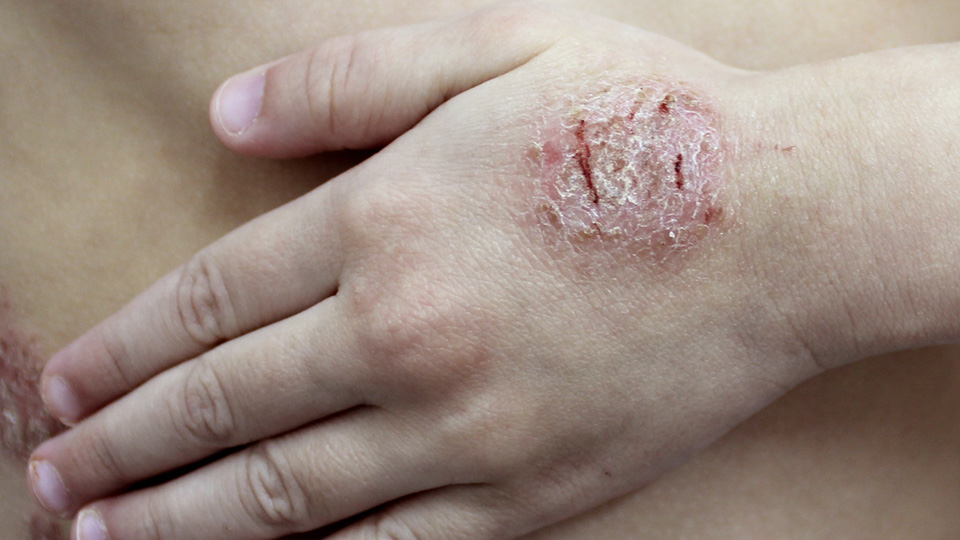Nummular dermatitis, also referred to as discoid eczema, is a chronic inflammatory skin condition marked by the presence of coin-shaped, itchy, and scaly lesions. The term “nummular” is derived from the Latin word for coin, reflecting the distinct round or oval configuration of the skin plaques. This condition can significantly impair quality of life, often recurring or persisting for months or years.

Epidemiology and Risk Demographics
Nummular dermatitis affects individuals of all ages but is most common in middle-aged to older adults, particularly males. It is also observed in children and young adults, especially those with atopic tendencies or dry skin. Seasonal variation is noted, with flares frequently occurring in cold, dry climates.
Pathophysiology and Underlying Mechanisms
The precise pathogenesis of nummular dermatitis remains unclear, but the condition is associated with a compromised skin barrier, hypersensitivity reactions, and inflammatory processes.
Key contributors include:
- Impaired lipid content in the stratum corneum
- Disruption of epidermal hydration
- Immune dysregulation and T-cell-mediated inflammation
- Secondary infections (e.g., Staphylococcus aureus)
Common Triggers and Aggravating Factors
- Dry skin (xerosis)
- Frequent bathing or harsh soaps
- Cold, low-humidity environments
- Skin trauma or insect bites
- Allergens and irritants (metals, fragrances, detergents)
- Stress or immune compromise
- History of atopic dermatitis or other eczematous conditions
Identifying and minimizing exposure to these triggers is essential for long-term disease control.
Clinical Presentation and Symptoms
Characteristic Skin Lesions
The hallmark of nummular dermatitis is the sudden onset of multiple coin-shaped lesions that may appear on the arms, legs, torso, or hands. These lesions are typically:
- Pruritic and intensely itchy
- Erythematous with distinct borders
- Scaly or oozing, especially in acute flares
- Crusted or lichenified in chronic stages
- Symmetric or asymmetric in distribution
In some cases, secondary bacterial infection may result in weeping lesions, pustules, or foul odor.
Differential Diagnosis
Due to the visual similarities with other dermatological conditions, accurate diagnosis is essential. Differential diagnoses include:
- Tinea corporis (ringworm)
- Atopic dermatitis
- Psoriasis
- Allergic contact dermatitis
- Mycosis fungoides
- Nummular psoriasis
A potassium hydroxide (KOH) test may help rule out fungal infections, while biopsy is rarely necessary but useful in ambiguous cases.
Diagnostic Evaluation
Diagnosis of nummular dermatitis is primarily clinical, based on physical examination and medical history. Supporting evaluations may include:
- KOH preparation: To exclude dermatophyte infections
- Patch testing: If allergic contact dermatitis is suspected
- Skin biopsy: To confirm diagnosis in refractory or atypical cases
- Bacterial culture: If secondary infection is suspected
Evidence-Based Treatment Options
Topical Therapies
Corticosteroids
High-potency topical corticosteroids are the mainstay of treatment, particularly during flare-ups.
- Apply twice daily until resolution or for a limited course
- Occlusion therapy can enhance penetration
- Caution with prolonged use to avoid skin thinning
Calcineurin Inhibitors
For sensitive areas (face, genitalia), topical tacrolimus or pimecrolimus may be used as steroid-sparing agents.
Emollients and Moisturizers
Daily application of thick emollients helps repair the skin barrier and prevent recurrence.
- Prefer fragrance-free, ceramide-rich products
- Apply within minutes of bathing (soak and seal method)
Systemic Therapies
Reserved for severe or widespread cases, especially when topical agents fail:
- Oral corticosteroids: Short courses for rapid control
- Antibiotics: In cases of bacterial superinfection
- Antihistamines: For symptomatic relief of itching
- Phototherapy (NB-UVB): Effective in chronic, treatment-resistant cases
- Immunosuppressants: Methotrexate or cyclosporine may be considered in refractory conditions
Lifestyle Modifications and Home Care
- Use mild, non-soap cleansers
- Bathe in lukewarm water; avoid hot showers
- Avoid scratching; keep nails trimmed
- Wear soft, breathable fabrics (cotton preferred)
- Humidify indoor air during winter months
- Minimize exposure to allergens and irritants
Proactive skin hydration and consistent barrier maintenance are central to managing this chronic condition.
Complications and Prognosis
Untreated or poorly managed nummular dermatitis can lead to:
- Secondary bacterial infections
- Chronic lichenification and pigmentation changes
- Sleep disturbances due to pruritus
- Psychosocial stress or anxiety
With appropriate therapy and preventive care, most cases can be effectively controlled. However, recurrences are common, and ongoing skin care is crucial.
Summary of Clinical Recommendations
- Confirm diagnosis via clinical features; exclude mimics like fungal infections
- Initiate high-potency topical corticosteroids and emollients
- Address and eliminate potential triggers
- Educate patients on long-term skin care and recurrence prevention
- Consider systemic therapies for recalcitrant or extensive disease
Frequently Asked Questions
Q1: Is nummular dermatitis contagious?
No, nummular dermatitis is not contagious and cannot spread through skin contact.
Q2: Can stress trigger nummular dermatitis?
Yes, psychological stress can exacerbate symptoms and provoke flares.
Q3: What’s the best moisturizer for nummular eczema?
Thick, fragrance-free emollients like petroleum jelly, urea-based creams, or ceramide-rich lotions are recommended.
Q4: How long does it take to heal?
With proper treatment, lesions may resolve within 2–6 weeks, but maintenance is required to prevent relapses.
Q5: Can diet influence nummular eczema?
While not directly causative, food allergens or sensitivities may contribute in some individuals and merit further investigation.
Nummular dermatitis is a chronic, relapsing skin disorder that requires a multifaceted approach involving accurate diagnosis, potent topical treatments, lifestyle modification, and preventive strategies. Early intervention and patient education are critical to minimizing discomfort, preventing complications, and improving quality of life.